World’s largest mammal that ever walked the face of the earth used to live in Pakistan’s Balochistan province. Yes it is true.
 This mammal is called Baluchitherium (The Beast of Balochistan). So far the fossils of this mammal have only been found in Baluchistan and Central Asia.
This mammal is called Baluchitherium (The Beast of Balochistan). So far the fossils of this mammal have only been found in Baluchistan and Central Asia.
In 1999, a team of French Palaentologists discovered the complete skeleton of this giant mammal in Dera Bugti Hills of Pakistan. The find came as the result of a 5 month long expedition by the French Team in the Balochistan desert.
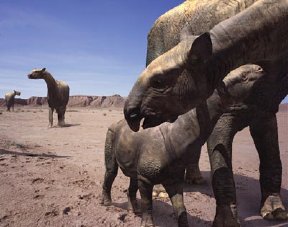 All in all it was a 5 year long on-and-off study. The French team was led by Professor Jean-Loup Welcomme of the Natural History Museum in Paris. While the first complete skeleton of Baluchitherium was dicscovered in 1999, it was as early as 1846 when first pieces of fossilized Baluchitherium were accidentally stumbled upon in Dera Bugti by a British Army officer who went by the name of Vickary.
All in all it was a 5 year long on-and-off study. The French team was led by Professor Jean-Loup Welcomme of the Natural History Museum in Paris. While the first complete skeleton of Baluchitherium was dicscovered in 1999, it was as early as 1846 when first pieces of fossilized Baluchitherium were accidentally stumbled upon in Dera Bugti by a British Army officer who went by the name of Vickary.
In 1909 another skeleton was found in the same area by a British team led by Mr. Forster-Cooper of the Cambridge Sedgwick Museum.
Following photo is a replica of Baluchitherium created for a museum in western hemisphere.
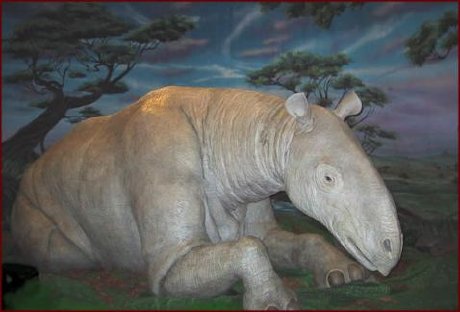
According to a BBC news report of May 10, 1999:
Baluchitherium is an extinct rhinoceros that lived during the Tertiary Period about 20 to 30 million years ago. With its long neck and legs, it was thought to feed high up in the trees. However, unlike the modern rhinoceros, the animal had no horn.
It had an estimated shoulder height of nearly 18 ft (5.5 m), a length of upto 28 feet (from nose to rump) and a weight of about 10 to 15 tons. The head was four feet long, sitting on top of a six feet long neck. This beast had poor eyesight, but made up for this with keen hearing and smell. Baluchitherium is classified in the phylum Chordata, subphylum Vertebrata, class Mammalia, order Perissodactyla, family Rhinocerotidae.
Following photo shows the French team and their Pakistani helpers recreating the skeleton of a Baluchitherium
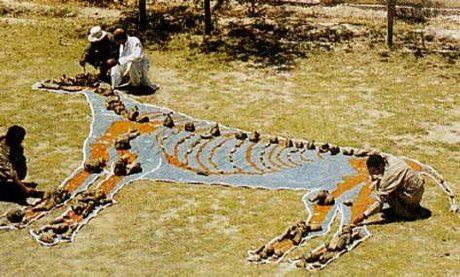
BBC News report further says that:
Although fossil remains of Baluchitherium have been discovered before, a near-complete skeleton has always evaded palaeontologists. The fact that the Baluchitherium was able to live in Baluchistan is giving scientists clues about the climate in the area millions of years ago.
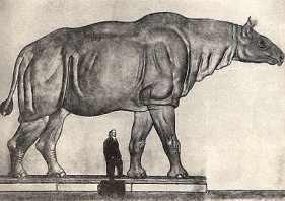 Eventhough Balochistan is now mostly a desert but since Baluchitherium would have needed as much as two tonnes of fodder every day, the French team believes this area of Pakistan must have been heavily forested.
Eventhough Balochistan is now mostly a desert but since Baluchitherium would have needed as much as two tonnes of fodder every day, the French team believes this area of Pakistan must have been heavily forested.
It is said that the Baluchitherium was a very defensive animal, and attacked any animal that was nearby. This beast tried to charge and trample foes with its front feet.
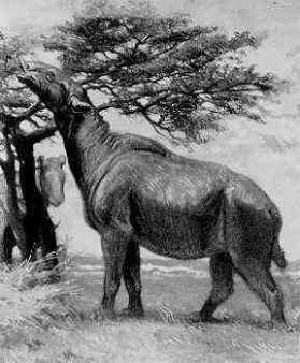 In an article written few years ago at www.thehotspotline.com blogger Ali Khan writes:
In an article written few years ago at www.thehotspotline.com blogger Ali Khan writes:
At a recent function organised by the Pakistan Embassy in Paris which saw the launch of the Pak-France cultural forum, professor Welcomme delivered a lecture on his recent find. He also thanked the Nawab of Bugti, the Bugti people and the University of Balochistan for extending all assistance to the French team. The Nawab of Bugti convinced other tribes to allow the team to work in the area and also provided material and technical assistance to Professor Welcomme‘s team.
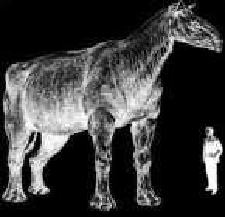 The latest news about Baluchitherium came last week when in early March 2008, more pieces of Baluchitherium have been excavated in Dera Bugti area. I read this update in Jang’s latest news feed but didn’t see the detailed news on it in the regular paper.
The latest news about Baluchitherium came last week when in early March 2008, more pieces of Baluchitherium have been excavated in Dera Bugti area. I read this update in Jang’s latest news feed but didn’t see the detailed news on it in the regular paper.
Is There A Baluchitherium Museum in Pakistan?
The short answer in NO.
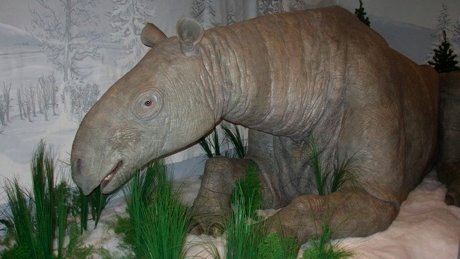
But then I am not familiar either with what has been done at Government level to help finding and preserving Baluchitherium fossils. A National museum displaying some fossils of this mammal who roamed the land of Pakistan before us is the need of the hour. Does any of our readers know about any effort in this regard? If we come to know of any effort, we’ll update this paragraph here with the new information.
Baluchitherium Trivia:
1. Baluchitherium is a Van Halen instrumental from their 10th studio album, Balance (album).
2. Baluchitherium is also the name of a monster appearing in the computer game NetHack.
Photo Credits:
1. 50birds.com
2. biocrawler.com
3. davo.com
4. Major Fossil find in Balochistan by Ali Khan
5. kokorodinosaurs.com
6. dionsoria.com
7. elachee.org
References:
1. Geological Survey of Pakistan
2. Major Fossil find in Balochistan by Ali Khan
3. BBC News Feed of May 10, 1999
4. Enchanted Learning
5. La Baluchitherium



















































Bol, magar piar se. Such bhat.
Umar says, “Great ideas are what make a country great.” I read that there are more Muslims in India than in Pakistan. They too feel great about being at home, I hope. Home is where belief, heart and head is. As an expatriate who lived in Pakistan for many years, I felt I was at home. I felt home was India as well. I grew up in pre-partition Taxila thinking, “mother india” thoughts, and I guess I will never shake that, though I am neither Muslim or Hindu. Haule or narmi se jana. Professor Bergsma.
“Long, long ago,” were favorite words of my father. We stood in front of some statues of Buddhist origin in Taxila in 1939 when we lived in that part of INDIA, long ago. I still have a buddha replica statue in my bedroom from that time. Not too long ago, in 1985 I travelled in Baluchistan near to the area where the Baluchitherium was discovered. I had visited Moheno-daro and other historic sites as well and marvelled at the art, the rich history and the cultural heritage of the area near to Quetta. I travelled in the NWFP and looked acrosss the Durand Line that divided Pakistan from Afghanistan, a strange line that had been drawn not too long ago. Long, long ago is wonderful to consider. There were wonders galore here before 1947, and after that time. ” The only problem with we Pakistanis is that till now we negated our pre 1947 history.” Dr. Nayar Hashmey. How true, how true. What is now Pakistan was part of something, not too long ago, is part of S.E Asia right now, and is part of world history, that means my history as well. We can rejoice in the now, as well as the not so long ago and the long, long ago my dad talked about. Jai Hi–story.
Thanks Owais for such a wonderful coverage on a mamoth in Balochistan.
Pakistan is host to a multiple of wonders. like the fossils of Mehrgarh in Balochistan which gave a firm clue on world’s first organized settlement (almost 17000 to 7000 years BCE). Again it was a son of this soil who inrtroduced dental surgery when the whole world did not know even abc of any thing.
The sites of Harappa and Mohenjo-Daro bespeak of this country’s heritage which gave the world its highly planned cities many milllenia before the Christ. In post-Christ era our Gandhara Civilization tells even today the mastery of this country’s artists and craftsmen.
Many years ago I met a Greek Professor in Venice.
While sitting in Venice’s famous Gondola, the Professor told me that he was in Taxila and he observed that even the Greek sculptors could not equal the art of sculptory fas exhibited by the Gandharans while patterning and finishing the life of Buddha depicted in the artefacts at Taxila.
The only problem with we Pakistanis is that till now we negated our country’s pre 1947 history.
I fully agree with the views expressed by Prof Ahmad hassan Dani (Pakistan’s only archeologist of world repute) and Aitzaz Ahson that even before 1947 the area called Pakistan has always been independent of the main land of India. In contrast to Gangetic civilisation that prospered in the present Indian lands, our side always sought anlightment from its Indus civilisation which is much older and far superior to the Gangetic civilisation.
By writing these lines I don’t mean we should live in our past, what I mean is, we should re-discover ourselves. ]
We are proud Muslims but we shouldd equally be proud of being Pakistanis. With such a rich heritage, we can strive to make this country great – great not in size but great in ideas, great in values and great in knowledge. That’s what makes a country great.
The resilience shown by this country, by its people, manifests what I say and BELIEVE.
Dr. Nayyar Hashmey
Baluchitherium is indeed the name of a song/instrumental by Van Halen. Not sure why they picked this name.
It’s a very interesting and well-researched article and few people within Balochistan know about Balochitherium or its genealogy. I myself saw it for the first time in a government office where a picture of it adorned the Commissioner’s table. So we definitely need further anlaysis and research as well as a greater awareness of the biological diversity in Balochistan and rest of Pakistan. Having said that I find it interesting (or distressing) that neither the writer not any of the commentators felt a need to refer to the contemporary residents of Dera Bugti who have been displaced from their homes as a result of the ongoing military operation. Many of these once proud people are reduced to begging for eking out a living in the vicinity of towns in Sindh and Balochistan. What this suggests is that it is considered acceptable behavior in Pakistan to talk about Balochistan (Dera Bugti/Gwadar) as a site of Pakistani nationalist imagination- the nationalist pride associated with the discovery of a huge land mammal is obvious in the responses- without giving a thought to the living conditions of the actual inhabitants of Balochistan. I am quiet sure that the people who wrote these comments have all the good wishes for the people of Dera Bugti and I doubt many of them support the military operation. What is interesting/distressing is that these well-intentioned people can engage in nationalist amnesia- forgetting the actual inhabitants of Dera Bugti- while talking about the region. One can calmly talk about whatever discoveries have been made there while at this time there may be gunship helicopters circling over people’s homes in Dera Bugti and many Bugtis themselves are living shelterless.